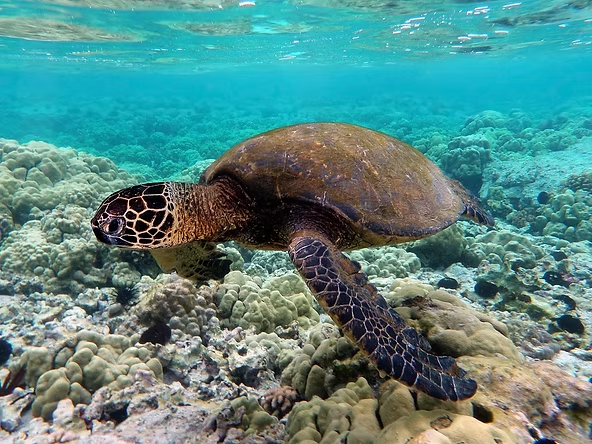What Is a Green Turtle?
The green turtle (Chelonia mydas) is one of the largest sea turtles in the world, instantly recognizable by its wide, smooth, heart-shaped carapace. Despite the name, its shell is usually brown or olive in color, while its skin has a distinctive greenish hue. These marine reptiles inhabit tropical and subtropical coastal waters worldwide and, unlike most sea turtles, have even been observed hauling themselves onto land to bask in the sun.
Populations and Distribution
Scientists recognize two main types of green turtles, though debate continues as to whether they represent subspecies or distinct species. The Atlantic green turtle ranges along the coasts of Europe and North America, while the Eastern Pacific green turtle can be found from Alaska all the way to Chile. Both populations share similar behaviors but adapt to their regional habitats in unique ways.
Size and Appearance
Green turtles are heavyweight ocean travelers, tipping the scales at up to 700 pounds. Their carapace can stretch to five feet in length, making them among the largest sea turtles alive today. Unlike other turtles, their head cannot retract into the shell. Males tend to be slightly larger than females and have noticeably longer tails. Both sexes use their powerful, paddle-like flippers to glide gracefully through the water.
Diet and Behavior
Green turtles are unique among sea turtles because adults are primarily herbivores, grazing on sea grasses and algae. This diet not only shapes their role in marine ecosystems but also contributes to the greenish tone of their body fat. Juveniles, however, are more opportunistic, feeding on invertebrates such as jellyfish, crabs, and sponges.
While most sea turtles rely on warm shallow waters to regulate their body temperature, Eastern Pacific green turtles sometimes come ashore to bask. This unusual behavior often places them alongside seals and seabirds like albatrosses, making them one of the few marine turtles to spend time on land outside of nesting season.
Breeding and Life Cycle
Like other sea turtles, green turtles undertake extraordinary migrations, traveling vast distances between feeding grounds and nesting beaches. Mating usually occurs every two to four years in shallow coastal waters. Females then haul themselves onto sandy beaches—often the very same beaches where they hatched—to nest. With their flippers, they dig a pit, deposit 100 to 200 eggs, and carefully cover them with sand before returning to the ocean. After about two months, the hatchlings emerge and race toward the sea, facing perilous odds as predators such as crabs, gulls, and fish prey on the vulnerable young.
Conservation Status
Despite their wide distribution, green turtles are classified as endangered. They are hunted for their meat and eggs in many regions, while accidental deaths from fishing nets, boat strikes, and coastal development further threaten their survival. The destruction of nesting habitats due to human activity also poses a major risk. Conservation efforts, including protected nesting beaches and stricter fishing regulations, are crucial to ensuring the survival of this ancient and remarkable species.

